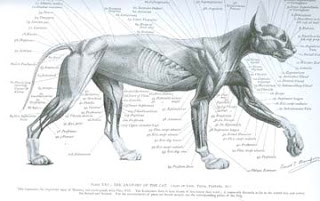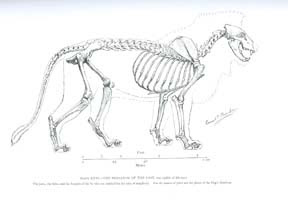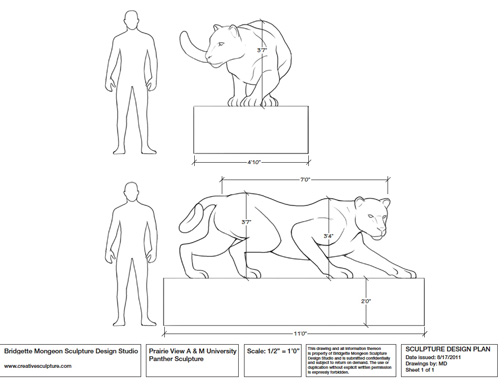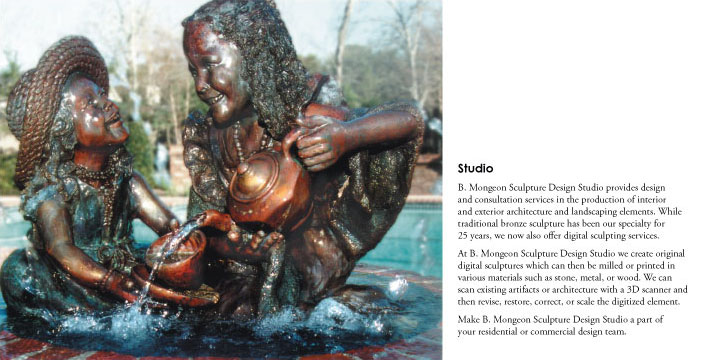Sculpture for Landscape
More Reference

Yes, you can never have too much reference material. It is important for any artist to know the anatomy of the subject they are working on.Unlike a human subject I can’t say to a “panther,”strike this pose for me, then take pictures from all sides. Instead, I rely on my years of artistic experience and a tremendous amount of reference.Once the foam armature comes to the studio, I’ll be studying it to see what needs to be shaved, carved, lengthened or turned, before I begin to add clay and personality to the piece.For anyone interested in the anatomy of animals I would highly suggest the bookAnatomy of Animals By Ernest Thompson. It was originally published in 1896 but you can get copies of it.Another fine book is Eduard Lanteri Modeling and Sculpting Animals.

This is from the Prairie View A&M Blog created for this project.
ENLARGEMENT BEGINS!
The file is off to my vendor in Oklahoma- introducing Synappsys Digital Services. They will take my digital file and enlarge it using foam and a milling machine. I wrote an article about this process in the Winter 2007 issue of Sculpture Review.Here is a pdf should you like to read the article and see the process.
This is from the Prairie View A&M Blog created for this project.
The Process – The Reason For A Digital Model

In traditional sculpting process a sculptor might present pencil sketches to a client to approve a design. Instead we sent digital models. The reason for these models are that we can see what a sculpture will look like from all directions. Sculpting is not like painting, you have to walk around the sculpture and have it present well from all sides. Digital models help us to do that. Another aspect of the digital model is that I can sculpt on it in the computer adding some detail before sending it off for enlargement. The digital model will really aid us in enlarging this sculpture as you will soon see. Before sending this off for enlargement the university requested I change the shape of the tail. They are concerned with breakage. We tried different tails with the pose and settled on something similar to this. Of course these are only digital sketches, of the direction we are going.
This is from the Prairie View A&M Blog created for this project.
More Research Big Cat Rescue

I am very indebted to Big Cat Rescue in Florida.Jeff Kremer, Director of Donor Appreciation, has spent a great deal of time with me talking about “panthers.” I have to say theiryou tube channel has been very inspiring and don’t be surprised if you find quite a few of their videos on this blog. They give me feline creativity.I’d like to introduce you to Jamanji. Look real close… can you see the spots?These photographs were taken from TheBig Cat Rescue website with their permission. Besides the 500 zoo photographs I must have another 100 or so photographs on my computer that are downloaded from the web. You can never have too much reference!
I am very indebted to Big Cat Rescue in Florida.

This is from the Prairie View A&M Blog created for this project.
What Is a Panther?
This is a very good question. As the carnivore keeper at the Houston Zoo- Josh Young said, “Saying you are sculpting a panther is like saying you are sculpting a bird.” “Panthera” is basically the genus of large cats, which would include lions, leopards jaguars, tigers cheetahs etc. What is the cat that most people think of when they say panther? It is a melanistic variant of another cat, most likely it is a black leopard or a jaguar. Now here is something really interesting, as the name states above, you can see spots on a “panther” black leopard if you look in the right light. So, for clarification we are looking at black leopards for this sculpture. But…. the black leopard does appear to be a smaller big cat… I went to my sources for this. Here is what Sam at the zoo had to say.
“Thanks for being patient with me as I gathered my facts for you! You were asking about black leopards specifically, so I will try to answer your questions without being too vague. Leopards are an interesting species to study as they are found in so many different habitats from Africa to Asia. Melanistic (or black) phased individuals are primarily found in southeast Asia and nearly all of the leopards on Java are melanistic. That being said, evolutionarily speaking, the black phase seemed to develop in the more densely forested areas as the darker color blends in better and these individuals could be more successful in hunting and avoiding detection. Another trait that develops in densely forested areas is smaller body size. Smaller predators can move more easily through the dense trees than larger ones. The reason I am telling you this is that if you look at leopard sizes they have a varied range (even among melanistic). Male Leopards average about 150lbs, but in some regions they can routinely reach 200lbs or more. Our spotted male weighs 130lbs and the black female weighs about 67lbs. Leopards average 3-6 feet from nose to tail, with tails averaging about 23-44 inches. Since you are looking at the melanistic phases, I would use the low end of that scale.”
Just to be safe we made our “panther” much bigger. I mean… it is, after all, a representation of something very big.
This is from the Prairie View A&M Blog created for this project.
How Big Is It?

That is a good question. Here is a sketch. Now, B. Mongeon Sculpture Design is not responsible for the pedestal, that would be the landscapers decision. But I’m for having a short pedestal. I am sure there are many students, visitors and alumni who will want to have their picture taken next to this massive sculpture. Hmmm. I wonder who will be the first? I hope you will all send your pictures to me Bridgette ( the at sign) creativesculpture.com. I would love to put them on the blog.
This is from the Prairie View A&M Blog created for this project.
Very Excited About New Marketing Brochure
We have been working diligently on a couple of different marketing plans and target markets. The first is a brochure that is going out to architects, landscape Architects, Interior Designers, and Landscape Designers.
I’m thrilled because it introduced our new digital sculpting services.
This is a tri fold brochure.It has been created by the new intern, Tiffany Post Actually she is not my intern she belongs to my husband’s company, MD Communications next door, but she has been on loan to me for the last couple of weeks. Tiffany is graduating from The Art Institute of Houston. She hopes to get a job in design. I am sure she would be open to freelance work if anyone needs anything, and at a good price. Great way for her to build a portfolio.

It can be a self mailer,
but who could put a label over that lion.
I really like the way the back came out.
Good thing the cards come with envelopes.
The printer we are using on this job was recommended by designer and photographer Christian Sizemore. She also does freelance work. WHCC has reasonable prices and does some nice work.
I would love to hear what others think about the brochure. Will be sent to printer next week.


______________________________________________________________________________

Sculptor, Writer and Speaker
Bridgette Mongeon is a sculptor, writer and educator as well as a public speaker.
Her blog can be found at https://creativesculpture.com.
She is also the owner and creator of the God’s Word Collectible Sculpture series
Follow the artists on twitter twitter.com/Sculptorwriter twitter.com/creategodsword
Facebook http://www.facebook.com/bridgette.mongeon
Listen to The Creative Christian Podcast or the Inspiration/Generation Podcast Click on Podcast Host Bios for a list of all podcasts.
Listen to the Art and Technology Podcast

